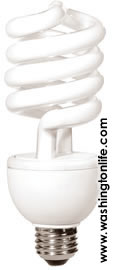|
GET ECO ACTIVE
15 things you can do
1. Don't use HEADACHE CAUSING TOXIC PAINT
Long after having dried, paint continues to emit noxious chemical odors. Milk paints are more natural and low in VOC's (volatile organic compounds). Avoid paints with formaldehyde, acetone or ammonia. Among other manufacturers, San Diegobased AFM Safecoat produces environmentally sensitive paints. Call (310) 838-8442 or (213) 413-4950 for more information.
2. FIND A HAZ BIN
Computers, old cell phones, paint cans, drained batteries, old fertilizer and fax and printer cartridges shouldn't be thrown in the trash; they leak unsavory substances into the ground and pollute our drinking water. Some manufacturers will take their products back to dipose of them. Or, contact local government authorities about better methods of disposing obsolete electronic equipment and other materials.
3. TURN it OFF
TVs,
computers and kitchen equipment still use power when turned off. Switch on the power save button or unplug them.
4. BUY NON-TOXIC MATRESSES, CARPETS AND FURNITURE
Have you ever gotten a headache or felt nauseous from a new carpet? Certain chemicals and flameretardants they contain are detrimental to your health. Next time, search Google to find thousands of non-toxic mattresses and carpets.
5. BIODIESEL and HYBRID CARs
They're cool. They save money and don't pollute the air as much as other vehicles.
6. COMPOST
A fetid pile of waste in the backyard sounds borderline crazy to many of us; however, composting makes your garden greener, eliminates the use of powersapping garbage disposals and reduces harmful greenhouse gas methane.
7. SAVE WATER
Lack of access to clean water has started wars. In America, we're depleting our water aquifers (reserves deep beneath the Earth's crust). You can save money each month by turning off the faucet while brushing your teeth and replacing your toilets with low-flow models.
8. EAT ORGANIC PRODUCE, WILD FISH AND HORMONE FREE MEAT AND DAIRY
All the taste, none of the toxins.
9. PLANT A TREE
They increase property value and afford much-needed privacy between yards. Amazingly, they save on air-conditioning bills as well. The American Forestry Association states that if every family planted one new tree, production of noxious greenhouse gas CO2 would be reduced by a billion pounds a year.
10. GREEN AND CLEAN DRY CLEANING
Dressing well doesn't have to degrade the environment. Clean your suit or dress at a dry cleaner that uses nontoxic liquid carbon dioxide products. To find a list of green cleaners visit www.greeenearthcleaning.com
11. BUILD YOUR DREAM HOME
Building your own home gives you ultimate green control. Contact the Institute of Architects (AIA) to find professionals who specialize in sustainable design, including those with accreditation through LEED (Leadership in Energy and Environmental Design,) the U.S Green Building Council's formal training program.
12. GET A CORDLESS ELECTRONIC MOWER
Old lawn mowers emit volatile organic compounds such as nitrogen oxides and carbon monoxide. These cause more pollution over the course of a year than driving a new car does.
13. MAKE LESS TRASH
Recycle. Paper versus plastic? Buy reuseable shopping bags and use them again and again.
14. USE LESS ENERGY
Coal-fired plants, where Americans get a large percentage of their energy, are the biggest culprits in greenhouse gas production. Buy appliances that have an Energy Star rating, meaning that they are extra efficient. Almost every drug or hardware store sells energy efficient light bulbs, which last longer as well.
15. FIX THE POOL
Tired of red eyes and green hair? Convert your pool to saline. Cover it, too; natural evaporation can take thousands of gallons of water a month. Plastic pool covers can reduce this loss by 90 percent.
IS DUST IN YOUR HOUSE KILLING YOU?
Scientists have found that household dust contains more nasty stuff than we might imagine, such as flame-retardant chemicals called polybrominated diphenyl ethers (PBDEs). According to two new analyses, the dust found throughout the typical house, especially near computers, is riddled with these substances. There are 209 different kinds of PBDEs being used in consumer products today. Recent studies have verified the increasing presence of flame-retardants in the bodily tissues of human beings and animals throughout the world. Researchers have been scrutinizing PBDEs since Swedish scientists discovered in 1999 that a 60-fold increase in the presence of these chemicals in breast milk had occurred between 1972 and 1997. Studies have found that the breast milk and blood of American women hold the highest levels of PBDEs found so far. These levels are 10 to 100 times higher than those found in European women. More frightening still, the amounts appear to be doubling every two to five years. The most worrisome aspect of this pollution is the ability of minute amounts of PBDEs to depress levels of key thyroidal hormones. This hormonal imbalance can have serious health consequences for adults that include fatigue, depression, anxiety, unexplained weight gain, hair loss and low libido. Children born to women experiencing such reduced hormonal levels are more likely to have low IQs. And studies have also linked PBDEs to permanent learning and memory impairment, behavioral changes, hearing deficits, delayed puberty onset, decreased sperm count, and other developmental disorders. The first study was sponsored by the Silicon Valley Toxics Coalition, the Computer TakeBack Campaign, and Clean Production Action. The second study was sponsored by the Environmental Working Group. Both tested dust samples in homes and found that every single one contained high levels of PBDEs. In lieu of federal action, states are seizing the initiative. Maine recently banned deca-PBDEs, and similar bills are being developed in New York, Massachusetts and Wisconsin. The state of Washington has issued an executive order to develop a phase-out plan for all PBDEs. The vast majority of PBDEs are used in computer and electronic products and household foams. Until these substances are removed from the market, consumers will have to take matters into their own hands and take their own precautions. Here are some tips you can use to keep PBDEs out of your home and body.
Dust busters:
- When you buy a new computer, make sure it's PBDE-free. Apple, Toshiba, Dell, NEC and Hewlett Packard are among the companies now offering equipment made without PBDEs. If you're unsure, call the manufacturer before you buy any electronic device.
- Don't open the case of your computer for cleaning or upgrades. Instead, take your machine to an outside location for professional servicing. Internal computer components become extremely dusty over time and this dust is easily and often contaminated with PBDEs that are then released into the air when disturbed by cleaning or maintenance.
- Clean the outside of your computer as well as floors and surfaces with a vacuum that has a HEPA filter. These filters catch dust and trap it for safe removal from the home. Many vacuums blow the smaller particles they catch back out into the air.
- Don't use feather dusters or other similar products that stir settled dust back into the air where it can be more easily inhaled. Use a damp cloth instead, and rinse it frequently in a bucket.
- Replace furniture and car seats that have torn upholstery and exposed foam.
- Exercise caution when removing or replacing foam padding beneath carpets.
- Make sure the manufacturer isn't using PBDEs before buying new furniture. Ikea is one chain that has removed these chemicals from its products.
- Avoid furniture that contains foam whenever possible. Opt instead for natural fiber stuffings like cotton and wool
- Consider wearing a dust mask when cleaning, especially if your home is particularly dusty.
- Don't use traditional commercial spray cleaners or furniture waxes. These contain harmful synthetic chemicals, too. For more information about the Silicon Valley Toxics Coalition report, visit www.computertakeback.com. For more information about the Environmental Working Group report, visit www.ewg.org/reports/inthedust. From the Non-Toxic Times, Seventh Generation Newsletter.
|



